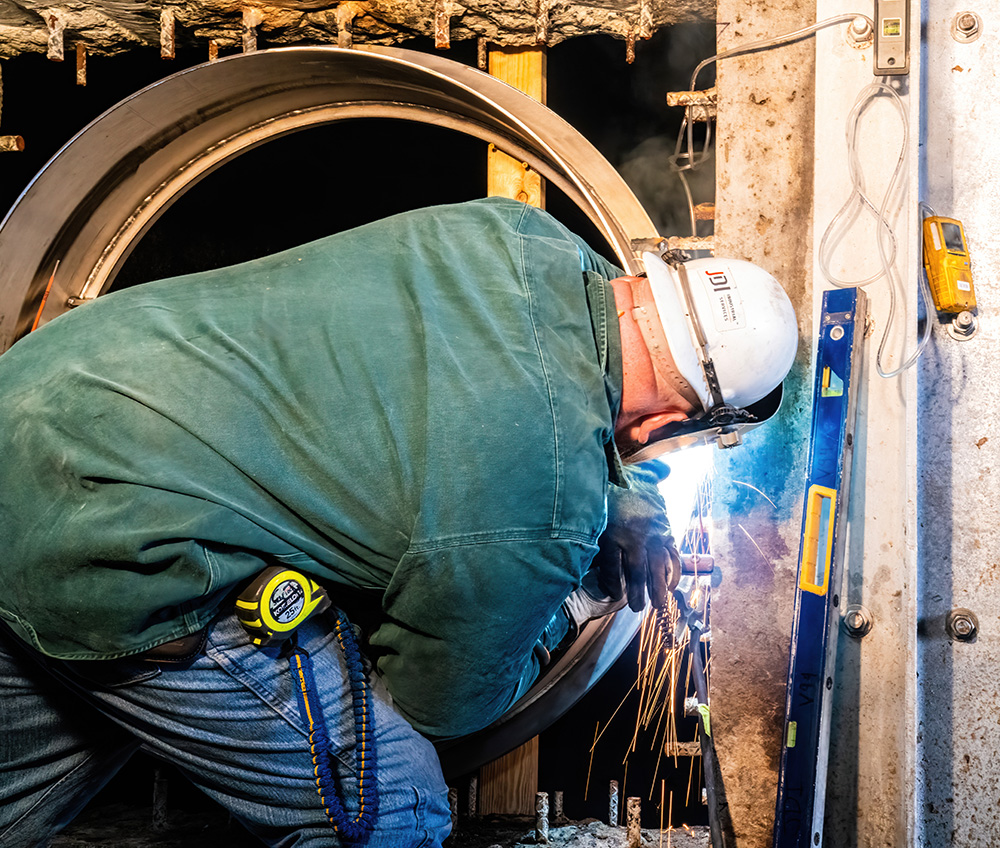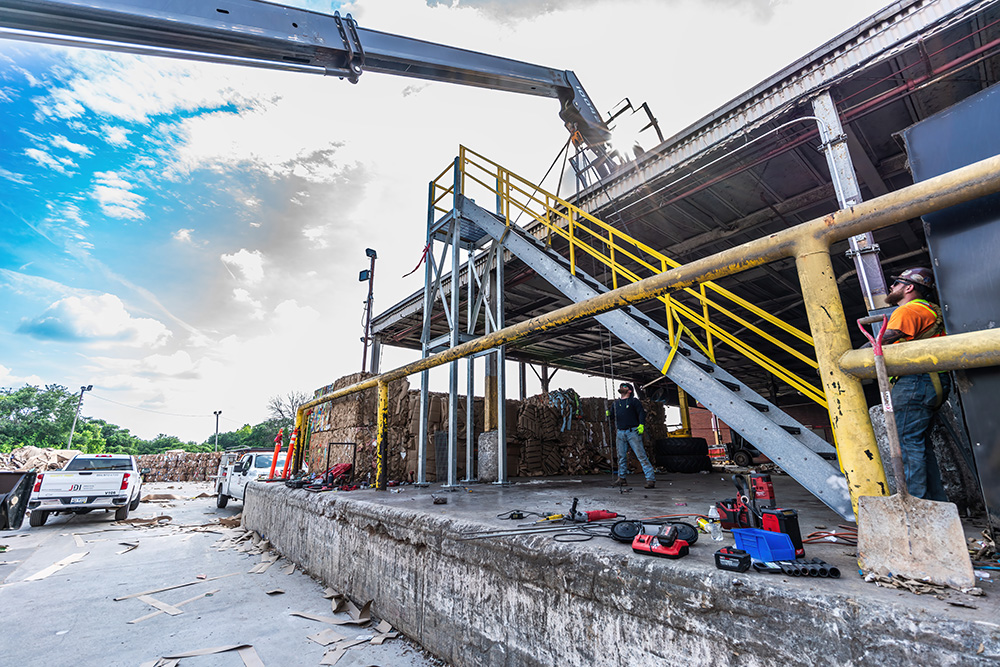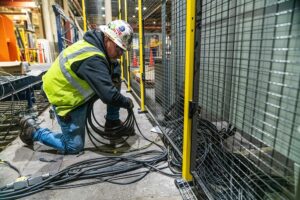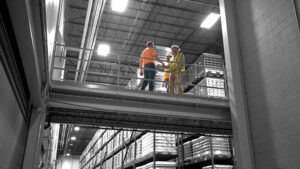Steel Fabrication refers to the fabrication process of transforming raw steel materials into predefined shapes, sizes, and configurations through cutting, bending, machining, welding, and assembling techniques.
Fabrication requires various stages from initial design and material selection to final assembly and finishing. Fabricators aim at producing structural components, repairs, machinery supports, equipment, and other products made from steel.
JDI’s own steel fabrication team plays a crucial role in modern manufacturing and construction industries in our region due to steel’s strength, durability, versatility, and the local demand.
It involves advanced technologies, skilled craftsmanship, and adherence to strict quality standards to produce high-quality steel products that meet functional, aesthetic, and safety requirements.
Steel Fabrication:
Key Concepts and Processes of Steel Fabrication
Firstly, steel fabrication is a complex and detailed metal fabrication process that involves the transformation of raw steel into a variety of products and structures used in construction, manufacturing, and other industries. Material selection, cutting, forming, joining, surface treatment, and assembly are all key components of steel fabrication.
- Material Selection – Selecting the correct material for the application is crucial. Tensile, yield, and compressive strength are all important material variables that need to be considered to avoid catastrophic failure.
- Cutting – Today’s fabricator has many ways to cut material to the correct length and size. Steel can be cut with saws, shears, abrasive wheels, plasma torches, oxy-acetylene torches, lasers, and waterjets to name a few.
- Forming – The process of creating angles, channels, beams, and equipment via rolling and bending.
- Joining – The welding process that fuses steel parts together through the application of heat or pressure. Steel connections can also be made with bolted connections or rivets.
- Surface Treatment – Involves surface preparation and coating the fabricated parts. Surface preparation can include using chemical or mechanical means to remove surface rust and contaminates so that the finish coating adheres to the base material properly. And more than just adding visual appeal to a fabricated component, material coating is all about ensuring that the part has the proper corrosion & wear resistance for the intended environment in which the part is used.
- Assembly – Often required once the prefabricated components are delivered to the site. This mostly involves pre-fabricated structures such as steel frames for construction, bridges, and other large structures. Also in assembly, the installation of structural steel components involves lifting and positioning steel components which is called steel erection.

Best Methods for Fabrication of Large Steel Structures
Fabricating large steel structures involves several specialized methods to ensure structural integrity, precision, and efficiency. By combining engineering, project management, safety protocols, non-destructive testing and other methods, with careful planning, advanced technology, and skill labor, fabrication of large steel structures can achieve high quality, cost-effectiveness, and while adhering to strict project timelines.
Therefore, each method contributes to ensuring that the final structure meets structural requirements, regulatory standards, and client expectations.
Design and Detailing
- This stage involves creating detailed plans, drawings, and specifications that outline the structure’s dimensions, load-bearing requirements, and other critical parameters.
- Design engineers and detailers use specialized software tools to model the structure and generate precise fabrication drawings.
- Advanced Building Information Modeling (BIM) software has revolutionized this stage, enabling multidisciplinary collaboration, clash detection, and accurate quantity take-offs.
- BIM allows stakeholders to visualize the entire structure and identify potential issues before fabrication starts.
Material Selection
- Choosing the right type and grade of steel is crucial for structural integrity and longevity; conversely, that also means having a fabricator like JDI that has the knowledge to deliver what a client needs for their project.
- Structural steel is available in various grades, each with specific mechanical properties suitable for different applications. Since engineers and fabricators need to carefully select the steel material, that also demands they understand the project’s requirements, including load-bearing capacity, corrosion resistance, and environmental factors.
- Common structural steel grades include A36, A572, A588, and A992. Steels used for building construction in the US use standard alloys identified and specified by ASTM International, typically identified for construction use beginning with the letter “A”. The choice of steel grade should consider factors such as the structure’s intended use, location, and exposure to environmental conditions.
Cutting and Shaping
- Laser cutting: Utilizes a high-powered laser beam to cut steel with precision, creating smooth edges.
- Waterjet cutting: Utilizes a high-pressure stream of water mixed with abrasive particles to cut through steel materials.
- Saw cutting: Employs circular or band saws to cut steel sections efficiently.
- Plasma cutting: Uses a high-velocity jet of ionized gas to cut through steel quickly and accurately.
Welding
- Shielded Metal Arc Welding (SMAW): Stick welding uses a consumable electrode coated in flux to create an arc that fuses the steel components.
- Gas Metal Arc Welding (GMAW): Also known as MIG welding, GMAW uses a continuous wire electrode and shielding gas to create a stable arc.
- Flux-cored Arc Welding (FCAW): Similar to GMAW, it uses a flux-filled wire electrode, eliminating the need for an external shielding gas.
- Submerged Arc Welding (SAW): Involves a granulated flux that blankets the welding area, protecting it from atmospheric contamination.
Quality Control and Inspection
- Visual inspections to identify surface defects and imperfections.
- Dimensional checks to ensure components meet design specifications.
- Non-destructive testing (NDT) methods, such as ultrasonic testing, magnetic particle testing, and dye penetrant testing, to detect hidden flaws or discontinuities.
- Welding inspections to verify the quality of welds, including weld size, penetration, and continuity.
- Material testing, including tensile and hardness testing, to verify the mechanical properties of the steel.
Surface Preparation and Coating
- Paint: Offers essential protection against corrosion and can be applied in various colors for aesthetic purposes.
- Galvanizing involves immersing steel components in molten zinc, creating a durable, corrosion-resistant coating.
- Powder coating: Provides a durable and aesthetically pleasing finish by electrostatically applying dry powder to the steel surface and curing it with heat. Companies who do powder coating such as H.B. Fuller, are responsible for creating the compounds necessary to increase durability.
Assembly and Erection
Once all components are fabricated, inspected, and coated, they are assembled into more significant sections or modules. These assemblies are then transported to the construction site for erection.
Proper assembly and erection procedures are critical to ensure the structure’s stability and safety. This phase may involve using heavy machinery, such as cranes and lifts, to position and secure steel components.
JDI provides rigging teams for just this sort of steel erection work. We believe that the client can rest assured that from start to finish the job is understood and can be properly delivered.
Testing and Commissioning
After the structure is fully erected, it undergoes tests and inspections to verify its integrity and functionality. These tests may include load testing, deflection testing, and structural integrity assessments. Once the structure passes these tests, it is ready for commissioning and use.
Why is Fabrication Important?
Steel fabrication is important for numerous reasons, spanning various industries and applications. Steel fabrication is fundamental to modern infrastructure, manufacturing, and various other industries due to its unparalleled combination of strength, versatility, cost-effectiveness, and environmental benefits.
One of the more compelling elements for some is emphasizing the need for steel that is affordable and yet strong enough for the structures they support.
Today, most structural steel produced in the United States is sourced from recycled scrap steel, and about 95% of the steel used in structural shapes in the United States is from recycled steel scrap material” (Hassan, 2020).
Steel fabrication enables the creation of robust, long-lasting structures and components that meet the demanding requirements of contemporary engineering and architectural projects. The following are the reasons why fabrication is important.
Structural Integrity and Strength
The first step of structural integrity is detailing shop prints in accordance with structural design drawings previously prepared by structural engineering design firm.
The structural design of a building involves selecting and arranging the structural components into an orderly and economical system capable of supporting all loads and forces of the structure’s architectural integrity (MacLaughlin, 2024, p. 50).
Durability and load-bearing ability are particularly important steps in structural integrity and strength.
Ensuring structural integrity and strength in steel fabrication is a multi-faceted process that involves careful planning, precise execution, and rigorous testing.
By selecting proper materials adhering to engineering principles, employing advanced fabrication techniques, and keeping stringent quality control, fabricators can produce steel structures that are safe, durable, and capable of withstanding that demands of their intended applications.
Versatility and Flexibility
The versatility and flexibility of steel in fabrication are key factors that drive its widespread use across various industries (MacLaughlin, 2024, p. 194). By using advanced materials, fabrication technology, and design tools, steel can be adapted to meet a wide range of requirements, from architectural innovation to industrial robustness.
This adaptability not only enhances the efficiency and effectiveness of construction and manufacturing processes but also allows for the realization of complex and ambitious projects that push the boundaries of engineering and design.
Efficiency in Construction
“Efficiency is important because it ensures that an assembly line keeps producing as many goods as possible in a given time period, increasing productivity and potential profits” (Indeed, 2024). Being efficient is especially important for the industrial fabricator involved because they affect the speed your work gets done, and the way you want it done.
Therefore, in construction the term efficiency refers to the effective use of resources – time, money, materials, and labor – to achieve the desired outcomes while minimizing waste and delays.
Also, it results in faster project completion, cost savings, enhanced quality, and greater flexibility.
The combination of off-site pre-fabrication, precision manufacturing, and innovative design capabilities makes steel an indispensable material in modern construction.
By using the advantages of steel fabrication, JDI projects can achieve higher productivity, reduce environmental impact, and deliver superior results, ultimately benefiting clients, contractors, and the broader community.

Environs and Safety
Environmental Considerations
Environmental considerations in steel fabrication encompass a wide range of factors, from resource efficiency and emissions reduction to sustainable manufacturing practices and innovation.
By addressing these aspects, the steel fabrication industry can significantly reduce its environmental footprint and contribute to broader sustainability goals.
Implementing advanced technologies, adhering to environmental standards, and promoting recycling and resource efficiency are key strategies for making steel fabrication more environmentally friendly.
This is not only helping the planet but also enhances JDI’s reputation and compliance with increasingly stringent environmental regulations.
Safety and Reliability
Ensuring safety and reliability in steel fabrication requires a comprehensive approach that spans material choice, design, fabrication, and ongoing maintenance.
By adhering to stringent quality standards, employing advanced technologies, and keeping rigorous safety protocols, the steel fabrication industry can produce structures that are not only robust and durable but also safe for their intended use.
This focus on safety and reliability protects lives and property and enhances the industry’s reputation and sustainability.
Application, technology, and cost
Applications Across Industries
Steel fabrication is a cornerstone of modern industry, providing the backbone for critical infrastructure, transportation, energy production, and advanced technological applications.
Its versatility, strength, and durability make it indispensable across a wide range of sectors, from construction and automotive to aerospace and healthcare.
By using advanced fabrication techniques and adhering to stringent quality and safety standards, steel fabrication continues to drive innovation and economic growth, ensuring the reliability and longevity of essential structures and systems.
Technological Advancements
Technological advancements in steel fabrication have revolutionized the industry, enhancing efficiency, precision, and sustainability. From advanced design tools like CAD and BIM to innovative fabrication techniques such as 3D printing, these innovations are especially driving the future of steel fabrication.
Improved materials, automation, and quality control methods further ensure that steel structures are not only strong and durable but also produced in an environmentally responsible manner.
Furthermore, embracing these technologies enables the steel fabrication industry to meet the growing demands of modern construction and manufacturing while minimizing its environmental impact.
Maintenance and Operation Cost
Lastly, the maintenance and operation costs of fabrication for a facility depend on several factors including the size of the facility, the complexity of operations, the types of equipment used, and the materials processed. Effective management of maintenance and operation costs in fabrication involves balancing investments in equipment reliability, operational efficiency, and workforce capability.
Consequently, the cost mostly depends on energy, labor, raw material, and credit read in a JRC Technical report (Mederac et al., 2024, pg. 15). By implementing proactive maintenance strategies, improving processes, and managing resources efficiently fabrication facilities can control cost while supporting high- quality production standards and ensuring a safe working environment.
Sources:
Hassan, M. (2020, July 23). Structural Steel Design, _by_abi_o._aghaye 3rd ed. Academia.edu. https://www.academia.edu/43694520/Structural_Steel_Design_by_Abi_O_Aghaye_3rd_ed
MacLaughlin, D. Structural Steel Drafting. Delmar Publishers. 19 July 2024.
Medarac, H., Moya, J. A., & Somers, J. (n.d.). Production costs from iron and steel industry in the EU and … https://www.eurofer.eu/assets/news/eu-technical-report-on-production-costs-from-the-iron-and-steel-industry-in-the-eu-and-third-countries/production_costs_from_the_iron_and_steel_industry_-_final_online.pdf
What is manufacturing efficiency? (with helpful tips) | indeed.com. (n.d.). https://www.indeed.com/career-advice/career-development/what-is-manufacturing-efficiency. 19 July 2024.


